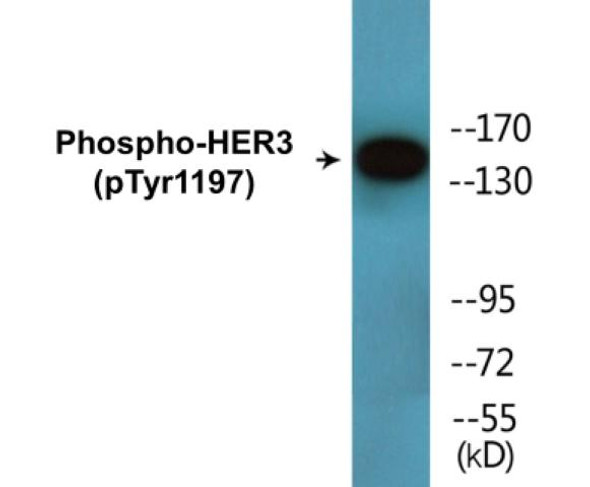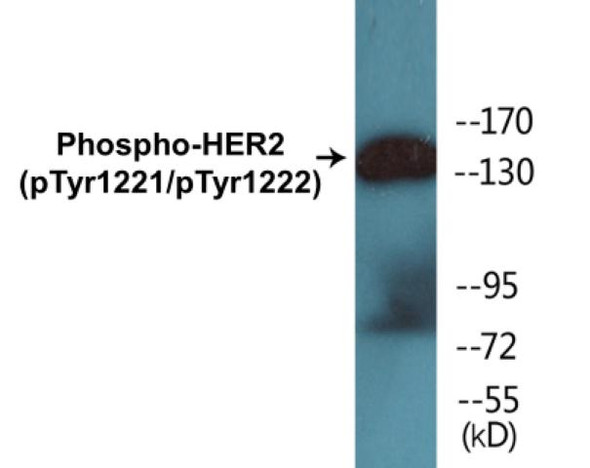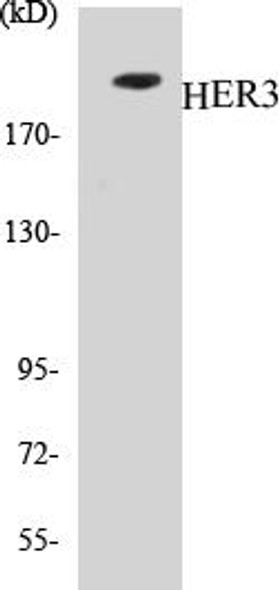Description
HER3 (Phospho-Tyr1222)Colorimetric Cell-Based ELISA Kit
The HER3 Phospho-Tyr1222 Colorimetric Cell-Based ELISA Kit is a powerful tool for measuring phosphorylated HER3 protein levels in cell lysates. This kit offers high sensitivity and specificity, allowing for accurate and reproducible results in a variety of cell-based research applications.HER3 (human epidermal growth factor receptor 3) is a crucial member of the HER family of receptor tyrosine kinases, playing a significant role in cell growth, survival, and differentiation. Phosphorylation of HER3 at tyrosine 1222 is known to be a key regulatory event in the activation of downstream signaling pathways involved in tumorigenesis and cancer progression.
By using the HER3 Phospho-Tyr1222 Colorimetric Cell-Based ELISA Kit, researchers can gain valuable insights into the activation status of HER3 in cells, providing essential information for understanding its role in disease pathology and potential therapeutic targeting. Trust in this kit for reliable and accurate measurements of phosphorylated HER3 levels in your cell-based experiments.
| Product Name: | HER3 (Phospho-Tyr1222) Colorimetric Cell-Based ELISA |
| Product Code: | CBCAB01429 |
| ELISA Type: | Cell-Based |
| Target: | HER3 (Phospho-Tyr1222) |
| Reactivity: | Human |
| Dynamic Range: | > 5000 Cells |
| Detection Method: | Colorimetric 450 nm |
| Format: | 2 x 96-Well Microplates |
The HER3 (Phospho-Tyr1222) Colorimetric Cell-Based ELISA Kit is a convenient, lysate-free, high throughput and sensitive assay kit that can detect HER3 protein phosphorylation and expression profile in cells. The kit can be used for measuring the relative amounts of phosphorylated HER3 in cultured cells as well as screening for the effects that various treatments, inhibitors (ie. siRNA or chemicals), or activators have on HER3 phosphorylation.
Qualitative determination of HER3 (Phospho-Tyr1222) concentration is achieved by an indirect ELISA format. In essence, HER3 (Phospho-Tyr1222) is captured by HER3 (Phospho-Tyr1222)-specific primary (1ø) antibodies while the HRP-conjugated secondary (2ø) antibodies bind the Fc region of the 1ø antibody. Through this binding, the HRP enzyme conjugated to the 2ø antibody can catalyze a colorimetric reaction upon substrate addition. Due to the qualitative nature of the Cell-Based ELISA, multiple normalization methods are needed:
| 1. | A monoclonal antibody specific for human GAPDH is included to serve as an internal positive control in normalizing the target absorbance values. |
| 2. | Following the colorimetric measurement of HRP activity via substrate addition, the Crystal Violet whole-cell staining method may be used to determine cell density. After staining, the results can be analysed by normalizing the absorbance values to cell amounts, by which the plating difference can be adjusted. |
| Database Information: | Gene ID: 2065, UniProt ID: P21860, OMIM: 190151/607598, Unigene: Hs.118681 |
| Gene Symbol: | ERBB3 |
| Sub Type: | Phospho |
| UniProt Protein Function: | HER3: a receptor tyrosine kinase of the EGFR family. Binds and is activated by neuregulins and NTAK. Can form homodimers or ErbB-2/ErbB-3 heterodimers. Kinase domain lacks activity but heterodimerizes with other EGFRs to transduce growth signals. May be required for HER2 activity. Elevated expression in breast and other tumors is indicative of poor outcome. A secreted form is expressed in metastatic prostate cancer Two alternatively spliced isoforms have been described. |
| UniProt Protein Details: | Protein type:Oncoprotein; Kinase, protein; Protein kinase, tyrosine (receptor); Protein kinase, TK; Membrane protein, integral; EC 2.7.10.1; TK group; EGFR family Chromosomal Location of Human Ortholog: 12q13 Cellular Component: extracellular space; basolateral plasma membrane; integral to plasma membrane; apical plasma membrane; plasma membrane; receptor complex; lateral plasma membrane Molecular Function:identical protein binding; protein binding; transmembrane receptor activity; protein homodimerization activity; protein heterodimerization activity; protein-tyrosine kinase activity; growth factor binding; protein tyrosine kinase activator activity; ATP binding Biological Process: epidermal growth factor receptor signaling pathway; phosphoinositide 3-kinase cascade; fibroblast growth factor receptor signaling pathway; phosphoinositide-mediated signaling; nerve growth factor receptor signaling pathway; wound healing; heart development; cranial nerve development; negative regulation of cell adhesion; signal transduction; protein amino acid phosphorylation; peripheral nervous system development; negative regulation of signal transduction; regulation of cell proliferation; Schwann cell differentiation; positive regulation of phosphoinositide 3-kinase cascade; neuron apoptosis; innate immune response; negative regulation of secretion; negative regulation of neuron apoptosis; transmembrane receptor protein tyrosine kinase signaling pathway Disease: Lethal Congenital Contracture Syndrome 2 |
| NCBI Summary: | This gene encodes a member of the epidermal growth factor receptor (EGFR) family of receptor tyrosine kinases. This membrane-bound protein has a neuregulin binding domain but not an active kinase domain. It therefore can bind this ligand but not convey the signal into the cell through protein phosphorylation. However, it does form heterodimers with other EGF receptor family members which do have kinase activity. Heterodimerization leads to the activation of pathways which lead to cell proliferation or differentiation. Amplification of this gene and/or overexpression of its protein have been reported in numerous cancers, including prostate, bladder, and breast tumors. Alternate transcriptional splice variants encoding different isoforms have been characterized. One isoform lacks the intermembrane region and is secreted outside the cell. This form acts to modulate the activity of the membrane-bound form. Additional splice variants have also been reported, but they have not been thoroughly characterized. [provided by RefSeq, Jul 2008] |
| UniProt Code: | P21860 |
| NCBI GenInfo Identifier: | 54792102 |
| NCBI Gene ID: | 2065 |
| NCBI Accession: | NP_001005915.1 |
| UniProt Secondary Accession: | P21860,Q9BUD7, A8K6L6, B4DIK7, B4DV32, E9PDT8, |
| UniProt Related Accession: | P21860 |
| Molecular Weight: | 148,098 Da |
| NCBI Full Name: | receptor tyrosine-protein kinase erbB-3 isoform s |
| NCBI Synonym Full Names: | v-erb-b2 erythroblastic leukemia viral oncogene homolog 3 (avian) |
| NCBI Official Symbol: | ERBB3 |
| NCBI Official Synonym Symbols: | HER3; LCCS2; ErbB-3; c-erbB3; erbB3-S; MDA-BF-1; c-erbB-3; p180-ErbB3; p45-sErbB3; p85-sErbB3 |
| NCBI Protein Information: | receptor tyrosine-protein kinase erbB-3; proto-oncogene-like protein c-ErbB-3; tyrosine kinase-type cell surface receptor HER3 |
| UniProt Protein Name: | Receptor tyrosine-protein kinase erbB-3 |
| UniProt Synonym Protein Names: | Proto-oncogene-like protein c-ErbB-3; Tyrosine kinase-type cell surface receptor HER3 |
| Protein Family: | Receptor tyrosine-protein kinase |
| UniProt Gene Name: | ERBB3 |
| UniProt Entry Name: | ERBB3_HUMAN |
| Component | Quantity |
| 96-Well Cell Culture Clear-Bottom Microplate | 2 plates |
| 10X TBS | 24 mL |
| Quenching Buffer | 24 mL |
| Blocking Buffer | 50 mL |
| 15X Wash Buffer | 50 mL |
| Primary Antibody Diluent | 12 mL |
| 100x Anti-Phospho Target Antibody | 60 µL |
| 100x Anti-Target Antibody | 60 µL |
| Anti-GAPDH Antibody | 60 µL |
| HRP-Conjugated Anti-Rabbit IgG Antibody | 12 mL |
| HRP-Conjugated Anti-Mouse IgG Antibody | 12 mL |
| SDS Solution | 12 mL |
| Stop Solution | 24 mL |
| Ready-to-Use Substrate | 12 mL |
| Crystal Violet Solution | 12 mL |
| Adhesive Plate Seals | 2 seals |
The following materials and/or equipment are NOT provided in this kit but are necessary to successfully conduct the experiment:
- Microplate reader able to measure absorbance at 450 nm and/or 595 nm for Crystal Violet Cell Staining (Optional)
- Micropipettes with capability of measuring volumes ranging from 1 µL to 1 ml
- 37% formaldehyde (Sigma Cat# F-8775) or formaldehyde from other sources
- Squirt bottle, manifold dispenser, multichannel pipette reservoir or automated microplate washer
- Graph paper or computer software capable of generating or displaying logarithmic functions
- Absorbent papers or vacuum aspirator
- Test tubes or microfuge tubes capable of storing ≥1 ml
- Poly-L-Lysine (Sigma Cat# P4832 for suspension cells)
- Orbital shaker (optional)
- Deionized or sterile water
*Note: Protocols are specific to each batch/lot. For the correct instructions please follow the protocol included in your kit.
| Step | Procedure |
| 1. | Seed 200 µL of 20,000 adherent cells in culture medium in each well of a 96-well plate. The plates included in the kit are sterile and treated for cell culture. For suspension cells and loosely attached cells, coat the plates with 100 µL of 10 µg/ml Poly-L-Lysine (not included) to each well of a 96-well plate for 30 minutes at 37 °C prior to adding cells. |
| 2. | Incubate the cells for overnight at 37 °C, 5% CO2. |
| 3. | Treat the cells as desired. |
| 4. | Remove the cell culture medium and rinse with 200 µL of 1x TBS, twice. |
| 5. | Fix the cells by incubating with 100 µL of Fixing Solution for 20 minutes at room temperature. The 4% formaldehyde is used for adherent cells and 8% formaldehyde is used for suspension cells and loosely attached cells. |
| 6. | Remove the Fixing Solution and wash the plate 3 times with 200 µL 1x Wash Buffer for five minutes each time with gentle shaking on the orbital shaker. The plate can be stored at 4 °C for a week. |
| 7. | Add 100 µL of Quenching Buffer and incubate for 20 minutes at room temperature. |
| 8. | Wash the plate 3 times with 1x Wash Buffer for 5 minutes each time. |
| 9. | Add 200 µL of Blocking Buffer and incubate for 1 hour at room temperature. |
| 10. | Wash 3 times with 200 µL of 1x Wash Buffer for 5 minutes each time. |
| 11. | Add 50 µL of 1x primary antibodies Anti-HER3 (Phospho-Tyr1222) Antibody, Anti-HER3 Antibody and/or Anti-GAPDH Antibody) to the corresponding wells, cover with Parafilm and incubate for 16 hours (overnight) at 4 °C. If the target expression is known to be high, incubate for 2 hours at room temperature. |
| 12. | Wash 3 times with 200 µL of 1x Wash Buffer for 5 minutes each time. |
| 13. | Add 50 µL of 1x secondary antibodies (HRP-Conjugated AntiRabbit IgG Antibody or HRP-Conjugated Anti-Mouse IgG Antibody) to corresponding wells and incubate for 1.5 hours at room temperature. |
| 14. | Wash 3 times with 200 µL of 1x Wash Buffer for 5 minutes each time. |
| 15. | Add 50 µL of Ready-to-Use Substrate to each well and incubate for 30 minutes at room temperature in the dark. |
| 16. | Add 50 µL of Stop Solution to each well and read OD at 450 nm immediately using the microplate reader. |
(Additional Crystal Violet staining may be performed if desired – details of this may be found in the kit technical manual.)






